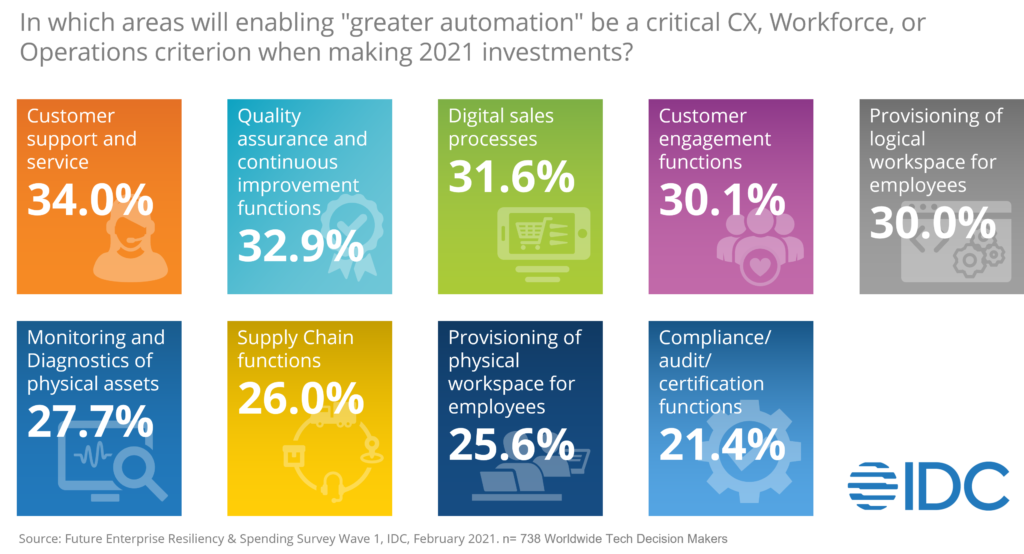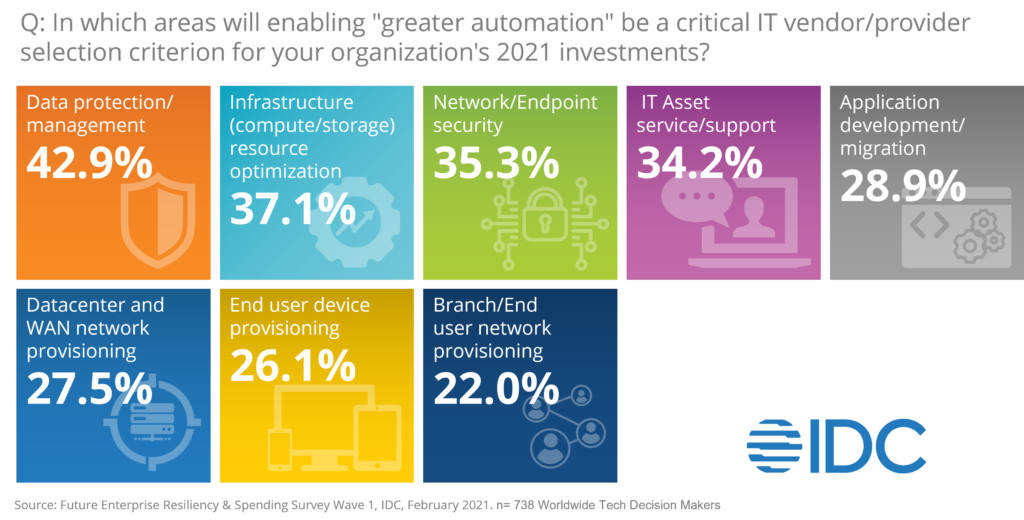What do augmented, contactless, robotic process automation (RPA), and digital assistant technologies have in common? They are all essentially automation. And, automation is the foundation on which enterprises will build greater digital resiliency.
Automation is not a new concept. IDC has covered a variety of automation technologies, including office automation, factory automation, business process automation, and if you think about cloud infrastructure, it’s simply the automated delivery and operation of compute and storage resources. Automated IT Operations, a key element in developing digital infrastructure strategy, is all about automation.
What’s different today is that enterprises recognize the need for automation at scale across the entire organization – essentially making automation part of a business’ DNA. As business and IT leaders strive to achieve that goal, they’ll need to overcome two broad sets of barriers – data and people.
Data barriers are associated with things like the ability to integrate data from many sources, including increasingly external ones. Even when companies have the data, they often can’t take advantage of it in real time, which is critical to making automation work.
The second set of barriers are people problems. It is difficult to reach a common understanding across the organization about what the data means and what policies should be applied. In many cases, organizations don’t have processes to set standards and rules. In addition, many companies are realizing that they lack the skills – and the expertise – to apply automation at scale.
As organizations work to address these broad sets of challenges, they will also need to clear major hurdles. Avoiding silos is a major challenge when it comes to business automation. IDC’s Future Enterprise Resiliency & Spending survey identified targeted business automation efforts as high priorities for virtually all companies. Areas where business leaders want to use automation, and where IT leaders need to support those efforts, include improving customer support and engagement, enhancing quality assurance processes/programs, and augmenting sales processes (see figure below)

If we look at all of these areas, we can see the risk – companies initiating many different automation projects to address issues within specific silos. A manufacturer like Volkswagen offers an instructive example of the advantages, but also the risks to be avoided. They have an initiative to create the Volkswagen Industrial Cloud – what they call their digital production platform (DPP). This is a very aggressive multibillion dollar initiative across their entire brand portfolio and across all of their factories. It requires coordination and collaboration with third parties, including with strategic technology partners like AWS.
At the same time, Audi, a VW brand, is working with a leading semiconductor and IT technology partner on a quality assurance initiative that addresses the process of verifying correct application of paint to vehicles. VW needs to be sensitive to the risks of creating silos and ensure that both of these initiatives are implemented in a consistent, coherent, and cooperative way.
Creating an Enterprise Autonomic System
There is one “organization” that provides a relevant analog – the human body. We all depend on sophisticated automated systems – the circulatory system, the respiratory system, and our body temperature maintenance system. These and other functions comprise an incredibly sophisticated automated environment, but they don’t operate as independent silos. They work together to make humans one of the most resilient animals on the planet, with high endurance levels and of the ability to live in diverse ecological environments. The reason that all of these systems work well is because they are linked by an autonomic nervous system (ANS).
Digitally resilient organizations must create their own enterprise-scale versions of an autonomic nervous system. This Enterprise ANS must be built on four elements
- Companies need to agree on a common set of data and application definitions and rules, which can be applied across the entire enterprise. New initiatives like Open Telemetry will play a big role here, but there will be others that are more industry specific.
- Organizations have to attack the real-time problem – creating digital infrastructure environments that ensure ubiquitous delivery of compute and memory resources to every location and every edge environment. These include new solutions like dedicated cloud as a service, mobile edge computing/multi access edge computing (MEC) and solutions that enable real time data analysis and analytics.
- Enterprises must also adopt standard methods for moving data dynamically with assurances for security and reliability. The networking industry is going through a massive transformation right now and the concept of connectivity as a service will enable rapid, easy deployment of connectivity to support automation.
- They need a platform for creating a consistent, collective governance model that enables orchestration, performance management, and configuration control. This platform will be built on a cloud control plane. My colleagues have published some great research on the future of control planes.
When the topic of cloud control planes comes up, many IT leaders brace themselves for the next “one control plane to rule them all” battle or the emergence of the next master control program (MCP). But, that misses the point. This evolving cloud control plane discussion is not about control; it’s about creating an ecosystem where different developers who can leverage a standard control plane and set of services to create and deliver consistent, coherent, and cooperative automated services. To learn more about the cloud control plane’s critical role in automation, read IDC’s white paper, 10 Investment Areas for Optimizing Connected Cloud Management.
Preventing Over Automation
Automation and IT automation are very popular topics right now. Infrastructure, security, and management products and services partners are all introducing automation in their products. The problem, however, is many of their customers still consider automation a toy. IT administrators may use to address a specific task they deal with, but there is no widespread attempt to step back and figure out how to implement automation in a more systemic way to effect positive business-wide improvements.

IDC believes that over half of all the automation initiatives associated with workspace, business, and IT automation will actually fail – not because of lack of insight into the potential benefits, but because the IT teams tasked with implementing, delivering, and supporting them will not have the right skills and capabilities to use automation effectively.
Some technology suppliers are addressing this issue by adding AI/ML to products to remove some of the complexity and take decisions out of people’s hands. While that can be helpful, it is important to remember that no matter how brilliant AI/ML solutions become, people must still set the goals and assess the results. They need non-technical skills in areas like critical thinking, change management, and collaboration across groups.
Limiting Autonomic Disruptions
Returning to the analogy of the human autonomic nervous system, along with all the benefits, we all must deal with diseases, problems, conditions associated with the autonomic nervous system itself – when it comes to the autonomous enterprise and digital infrastructure IT team need to remain vigilant for three different types of risks.
External Threats: Lyme disease is a good example of an external threat. It’s a virus that actually attacks the autonomic nervous system and uses it to disperse itself and disrupt many different automated systems.
In the enterprise space, the SolarWinds incident is an example of a similar challenge. SolarWinds was not a break-in into a specific piece of technology. It was an attack that exploited the way that SolarWinds delivers network and security process innovation to enterprise customers. One of the most important new developments in the coming years will be the idea of “trusted automation”, which seeks to mitigate this type of risk. Technologies, such as confidential computing and zero trust networking, promise to help.
Voluntary Overrides: Individuals can cause major disruptions in their own body – hyperventilation, for example, is a conscious effort by an individual to override their autonomic nervous system. Unchecked, it can cause serious distress. Outages, which happen across all the cloud environments – large and small, public and private – are often linked to a similar “human error”. A smart individual took advantage of some very sophisticated automation capabilities to add capacity or better use existing resources, but ended upbringing down a network, a zone or the entire environment.
To minimize this risk, cloud providers think about the idea of a blast radius. They intentionally set limits and boundaries on where automation is used, so that an inadvertent change does not disrupt an entire system. Enterprises need to adopt similar ideas.
Systemic risks: We can develop serious and chronic conditions linked to small but sustained conflicts between different autonomic systems. Consider diabetes Type 2 Autonomous enterprises must adopt a healthy automation lifestyle in order to prevent the buildup of systemic risks. This means investing significantly in products and services that improve the observability of environments, enabling quick and effective preventative actions.
Automation of business and IT will be top priorities, but enterprises must address significant challenges. Automation needs to be implemented at scale across the enterprise in a way that avoids silos. Ultimately, automation is the key to building digital resiliency and helping your company better connect with, service, and deliver innovation to your customers.
Interested in learning more about the Future of Digital Infrastructure? Read 10 Investment Areas for Optimizing Connected Cloud Management:




